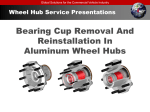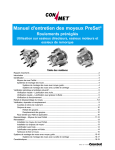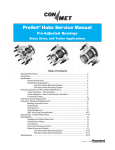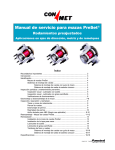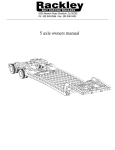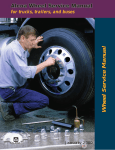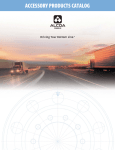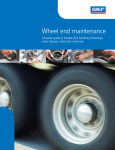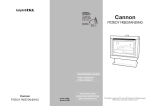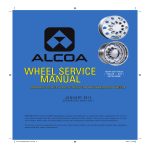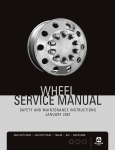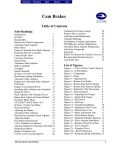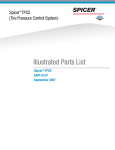Download ConMet PreSet PreGreased Wheel Ends
Transcript
™ ConMet™ PreSet® PreGreased Service Manual For Grease Lubricated Trailer Hub Assemblies CMI-100M-199 CONTENTS I M P O R T A N T R E M I N D E R S . . . . . . . . . . . . . . . . . . . . . . . . . . . . . . . . . . . . . . . . . . . . . . . . . . . . . . . . . . . . . . . . . . . . . . . . . . . . . . . . . . . . . . . . . . . . . . . . . . . . . . . . . . . . . . .i INTRODUCTION.....................................................................................................1 IDENTIFICATION ....................................................................................................2 P R E S E T P R E G R E A S E D W H E E L E N D S . . . . . . . . . . . . . . . . . . . . . . . . . . . . . . . . . . . . . . . . . . . . . . . . . . . . . . . . . . . . . . . . . . . . . . . . . . . . . . . . . . . . .2 P A R T N U M B E R L O C A T I O N . . . . . . . . . . . . . . . . . . . . . . . . . . . . . . . . . . . . . . . . . . . . . . . . . . . . . . . . . . . . . . . . . . . . . . . . . . . . . . . . . . . . . . . . . . . . . . . . . . .2 W H E E L M O U N T I N G S Y S T E M S . . . . . . . . . . . . . . . . . . . . . . . . . . . . . . . . . . . . . . . . . . . . . . . . . . . . . . . . . . . . . . . . . . . . . . . . . . . . . . . . . . . . . . . . . . . . . .3 H U B P I L O T W H E E L M O U N T I N G S Y S T E M . . . . . . . . . . . . . . . . . . . . . . . . . . . . . . . . . . . . . . . . . . . . . . . . . . . . . . . . . . . . . . . . . . . . . . . . .3 B A L L S E A T W H E E L M O U N T I N G S Y S T E M . . . . . . . . . . . . . . . . . . . . . . . . . . . . . . . . . . . . . . . . . . . . . . . . . . . . . . . . . . . . . . . . . . . . . . . . . .3 P E R I O D I C I N S P E C T I O N A N D P R E V E N T I V E M A I N T E N A N C E . . . . . . . . . . . . . . . . . . . . . . . . . . . . . . . . . . . . . . . . . . . . . . . . . . . . . . . . . . . . . . .4 V I S U A L I N S P E C T I O N . . . . . . . . . . . . . . . . . . . . . . . . . . . . . . . . . . . . . . . . . . . . . . . . . . . . . . . . . . . . . . . . . . . . . . . . . . . . . . . . . . . . . . . . . . . . . . . . . . . . . . . . . . . . . . . .4 O P E R A T I N G T E M P E R A T U R E . . . . . . . . . . . . . . . . . . . . . . . . . . . . . . . . . . . . . . . . . . . . . . . . . . . . . . . . . . . . . . . . . . . . . . . . . . . . . . . . . . . . . . . . . . . . . . . . . . . .4 F U N C T I O N A L C H E C K S . . . . . . . . . . . .. . . . . . . . . . . . . . . . . . . . . . . . . . . . . . . . . . . . . . . . . . . . . . . . . . . . . . . . . . . . . . . . . . . . . . . . . . . . . . . . . . . . . . . . . . . . .4 H U B R E M O V A L A N D D I S A S S E M B L Y . . . . . . . . . . . . . . . . . . . . . . . . . . . . . . . . . . . . . . . . . . . . . . . . . . . . . . . . . . . . . . . . . . . . . . . . . . . . . . . . . . . . . . . . . . . . . . .5 I N S P E C T I O N , R E P A I R , A N D R E P L A C E M E N T . . . . . . . . . . . . . . . . . . . . . . . . . . . . . . . . . . . . . . . . . . . . . . . . . . . . . . . . . . . . . . . . . . . . . . . . . . . . . . . . . . . .8 S E R V I C E K I T S . . . . . . . . . . . . . . . . . .. . . . . . . . . . . . . . . . . . . . . . . . . . . . . . . . . . . . . . . . . . . . . . . . . . . . . . . . . . . . . . . . . . . . . . . . . . . . . . . . . . . . . . . . . . . . . . . . . . .8 B E A R I N G C U P S A N D C O N E S . . . . . . . . . . . . . . . . . . . . . . . . . . . . . . . . . . . . . . . . . . . . . . . . . . . . . . . . . . . . . . . . . . . . . . . . . . . . . . . . . . . . . . . . . . . . . . . . . .8 W H E E L S T U D S . . . . . . . . . . . . . . . . . . . . . . . . . . . . . . . . . . . . . . . . . . . . . . . . . . . . . . . . . . . . . . . . . . . . . . . . . . . . . . . . . . . . . . . . . . . . . . . . . . . . . . . . . . . . . . . . .1 0 A BS T O N E R I N G ( A S A P P L I C A B L E ) .. . . . . . . . . . . . . . . . . . . . . . . . . . . . . . . . . . . . . . . . . . . . . . . . . . . . . . . . . . . . . . . . . . . . . . . . . . . . . . . . . . . . .1 1 R E A S S E M B L Y . . . . . . . . . . . . . . . . . . . . . . . . . . . .. . . . . . . . . . . . . . . . . . . . . . . . . . . . . . . . . . . . . . . . . . . . . . . . . . . . . . . . . . . . . . . . . . . . . . . . . .1 2 P R E S E T P R E G R E A S E D W H E E L E N D S . . . . . . . . . . . . . . . . . . . . . . . . . . . . . . . . . . . . . . . . . . . . . . . . . . . . . . . . . . . . . . . . . . . . . . . . . . . . . . . . . . . . . 12 R E I N S T A L L A T I O N . . . . . . . . . . . . . . . . . . . . . . . . . . . .. . . . . . . . . . . . . . . . . . . . . . . . . . . . . . . . . . . . . . . . . . . . . . . . . . . . . . . . . . . . . . . . . . . . . . . . . . . . . .1 5 I NSTALLING THE PRE S ET PREGREASED WHEEL END..................................................................15 IN S T A L L I N G T H E H U B C A P . . . . . . . . . . . . . . . . . . . . . . . . . . . . . . . . . . . . . . . . . . . . . . . . . . . . . . . . . . . . . . . . . . . . . . . . . . . . . . . . . . . . . . . . . . . . . . . . . . 1 6 B R A K E D R U M S A N D W H E E L S . . . . . . . . . . . . . . . . . . . . . . . . . . . . . . . . . . . . . . . . . . . . . . . . . . . . . . . . . . . . . . . . . . . . . . . . . . . . . . . . . . . . . . . . . . . . .1 7 H U B P I L O T W H E E L M O U N T I N G S Y S T E M . . . . . . . . . . . . . . . . . . . . . . . . . . . . . . . . . . . . . . . . . . . . . . . . . . . . . . . . . . . . . . . . . . . . . .1 7 B A L L S E A T W H E E L M O U N T I N G S Y S T E M . . . . . . . . . . . . . . . . . . . . . . . . . . . . . . . . . . . . . . . . . . . . . . . . . . . . . . . . . . . . . . . . . . . . . . .1 9 S P E C I F I C A T I O N S . . . . . . . . . . . . . . . . . . . . . . . . . . . . . . . . . . . . . . . . . . . . . . . . . . . . . . . . . . . . . . . . . . . . . . . . . . . . . . . . . . . . . . . . . . . . . . .2 1 IMPORTANT REMINDERS Read this manual carefully, providing extra attention to its explanations and instructions. To ensure safe, continuous, trouble-free operation, understand your wheel end system, and keep all components in proper operating condition. Pay particular attention to all NOTES, CAUTIONS, WARNINGS, and DANGERS to avoid the risk of personal injury or property damage, and realize these statements are not exhaustive. ConMet cannot possibly know or evaluate all conceivable methods in which service may be performed or the possibly hazardous consequences of each method. Accordingly, those who use a procedure not recommended by ConMet must first satisfy themselves that neither their safety nor the safety of the product will be jeopardized by the service method selected. Use only ConMet approved replacement parts. Do not attempt to use damaged parts. DISC WHEEL INSTALLATION PROCEDURES ( C o n M e t part number 103282) and PRESET PREGREASED DECALS (ConMet part number 106859) are available upon request. Notes These activities include additional information t h a t m a y a s s i st th e t e c h ni ci an in s e r v i c e NOTE procedures (see figure 1). FIGURE 1 Cautions These activities indicate that product damage may result from failing to heed the stated advisory (see figure 2). ! CAUTION FIGURE 2 Warnings Associated activities indicate that personal injury may result from failing to heed the advisory. Personal injury is not equated to career-ending ! WARNING injury but may result in possible change in quality FIGURE 3 of life (see figure 3). Dangers Associated activities indicate that death or serious personal injury may result from failing to heed the stated advisory. Serious personal injury may be equated to career-ending injury (see figure 4). i Consolidated Metco, Inc. ! DANGER FIGURE 4 CMI-100M-199 INTRODUCTION Inner Grease ABS Ring (Optional) Retainer Grease Seal Spring Retainer Inner Bearing Cone Outer Grease Inner Bearing Cup Retainer Spacer Consolidated Metco, Inc. is recognized as the leader in the design and manufacture o f light-weight components for the heavy truck industry. With the addition of PreSet® Wheel End technology to our family of products, ConMet now offers the best solution to prevent premature wheel end failures. Outer Bearing Cone Outer Bearing Cup ConMet's PreSet PreGreased Wheel Ends can extend service TN PreSet PreGreased Trailer Hub FIGURE 5 intervals up to 500,000 miles on highway applications, while still providing substantial weight savings to improve f u e l efficiency and increase payload capacity. Contact ConMet at 1-800-547-9473 or www.conmet.com. When installed as OEM equipment, ConMet PreSet PreGreased Wheel Ends offer up to a fiveyear/500,000 mile warranty on all components, including bearings and seals. With periodi c inspections and proper maintenance, actual service Literature # Description PreSet PreGreased Service Manual for CMI-100M-199 Grease Lubricated Trailer Hub Assemblies PreSet Service Manual CMI-101M-199 for Oil Lubricated Steer, Drive, and Trailer Hub Assemblies Service Manual for CMI-103M-199 Manually Adjusted Steer, Drive, and Trailer Hub Assemblies Corresponding Literature TABLE 1 CMI-100M-199 intervals can extend beyond 500,000 miles. These assemblies include ConMet lightweight aluminum hubs, premium grease seals, specially toleranced roller bearings pre-packed with Mobilith SHC 220 Grade 2 grease, and unique precision-machined bearing spacers, eliminating the need to manually adjust wheel end play. These components are delivered as a complete package, eliminating the potential for premature failure due to improper assembly and/or installation (see figure 5). For information on ConMet PreSet Oil Lubricated Wheel Ends and our standard lightweigh t aluminum hubs for manually adjusted bearings, refer to the corresponding service manual (see table 1). Contact ConMet at 1-800-547-9473 for other available technical or product information, or visit our web site at www.conmet.com. Consolidated Metco, Inc. 1 IDENTIFICATION PRESET PREGREASED WHEEL ENDS ConMet PreSet PreGreased Wheel Ends come complete with pre-greased, preinstalled cups and cones, grease retainers, and seals. These wheel ends are unique in that a precision tubular spacer is utilized between the bearings, eliminating the need f o r ma n u al b e aring ad justment (s ee figures 6 and 7). Preset TN Trailer Hub FIGURE 6 Preset TP Trailer Hub FIGURE 7 PART NUMBER LOCATION For additio nal information on your ConMet PreSet PreGreased Wheel End, locate the part numbers stamped on the hub. The hub assembly part number is located on the brake drum mounting surface in the recessed slots or on the Wheel stud part numbers Recessed Slots are found on the head of the stud. smooth machined surface between any of the wheel studs (see figure 8). The six digit assembly part number which is recessed in the hub may be separate or in combination with the production assembly date code. For example, 27299D1106412-1 is a production assembly code and is broken down as follows: 272 99 D1 106412 -1 Day of Year Operator Assembly Mfg. No. Code Year 2 Consolidated Metco, Inc. Note: The casting part number is found on the inboard end of the hub between the wheel stud heads and is in raised (embossed) numbers. This is not the final assembly number. Locating Part Numbers FIGURE 8 CMI-100M-199 IDENTIFICATION WHEEL MOUNTING SYSTEMS ConMet PreSet PreGreased Wheel Ends are available in both hub pilot and ball seat nut configurations. Hub Pilot Wheel Mounting System Single Dual The hub pilot wheel mounting system makes use of a single two piece flange nut on each wheel stud for both single and dual wheel applications (see figure 9). The hub pilot wheel mounting system is also known as th e Uni-Mount-10™ (10 stud), WHD-10™ (10 stud), WHD8™ (8 stud), and ISO system. Hub Pilot Mounting Systems FIGURE 9 Ball Seat Wheel Mounting System Single Dual The ball seat wheel mounting syste m makes use of the spherical contact area between the nut and wheel to both locate the wheel and hold the wheel tight against the brake drum (see figure 10). The ball seat wheel mounting system is also known as the stud piloted, ball seat Ball Seat Mounting Systems FIGURE 10 CMI-100M-199 cap nut (BCN) and double cap nut (DCN) system. Consolidated Metco, Inc. 3 PERIODIC INSPECTION AND PREVENTIVE MAINTENANCE ConMet recommends a complete inspection in conjunction with brake and/or tire service. NOTE In addit ion to the complete inspection at brake and/or tire service, maintain current sho p pre vent ive maintenance and pre-trip inspection practices. VISUAL INSPECTION With ConMet PreSet PreGreased Wheel Ends, there will be no visible leakage of grease or oil. Inspect for other visible signs of distress such as cracks in the hub or heat discoloration, as well as unusual tire wear. OPERATING TEMPERATURE Operating temperatures can be checked as the vehicle enters the service area following a normal run. If the hub is running at temperatures in e xc es s o f 15 0˚F above ambient in normal operating conditions, service is required. FUNCTIONAL CHECKS NOTE Conduct the following inspections with the wheel(s) and drum removed. ! DANGER Never work under a vehicle supported by a j a ck w i t ho ut supp orting th e vehicle with stands and blocking the wheels. Rotate the hub and check for free, smooth, and quiet rotation. If rotation is hampered, PreSet P reG r ea s ed W heel Ends should be serviced immediately. Also, check hub for excessive end play as follows in the End Play section, page 5. 4 Consolidated Metco, Inc. CMI-100M-199 PERIODIC INSPECTION AND PREVENTIVE MAINTENANCE End Play 1. Remove the hubcap, and use a dial indicator with a magnetic base mounted on the spindle end, to read the travel at the hub c ap mounting surface (see figure 11). 2. Grasp two wheel studs across from each other to pull and push the hub. 3. Measure the end play by the difference between the minimum and maximum dial indicator readings. ! CAUTION Checking for End Play FIGURE 11 PreSet PreGreased Wheel Ends should be serviced if end play exceeds 0.006". HUB REMOVAL AND DISASSEMBLY NOTE ConMe t rec om mend s Pre Set Pr eGre as e d Wheel End service at approximately 500,000 mile intervals. ! DANGER Never work under a vehicle supported by a jack without supp orting the v ehicle wi t h stands and blocking the wheels. 1. Prepare the axle for disassembly by using a jack to raise the axle until the wheels are off the ground, and the axle is proper ly supported. ! CAUTION Care should be taken to avoid damaging the hub or other components. CMI-100M-199 Consolidated Metco, Inc. 5 HUB REMOVAL AND DISASSEMBLY NOTE If you plan to replace the brake drum (i.e., full cast instead of Centrifuse™) or wheels Brake Drum Hub ( i. e., al um inum instead of steel), measure stud standout (see figure 12). In hub piloted mounting systems, the studs must be long enough for the threads to be exposed beyond th e in s ta ll e d w heel nut. In the ball seat mounting system, the stud length beyond the Measuring Stud Standout FIGURE 12 bra k e dr um s hould be from 1.31-1.44" as measured from the brake drum to the end of the stud. Call ConMet at 1-800-547-9473 fo r th e co rre ct stud part number for your application. If you plan to replace the brake drum, verify t h e n e w d r u m h a s t h e sa m e d r u m pi l ot diameter as the one that has been removed. 2. Remove the wheels and brake drum (see Removing the Wheels FIGURE 13 figure 13). 3. Examine the spindle nut to determine the locking system, and disengage the locking device. 4. Remove the spindle nut system (see figure 14). 5. Slide the hub off the spindle. ! CAUTION Occasionally, the seal can become stuck on t h e s p i n d l e , ma ki ng the hub dif fic ul t t o remove. If mechanical assistance is required to remove the hub, care should be used to avoid damage to wheel end components (see figure 15). In some cases, part of the seal will remain on the spindle. When removing this portion of the seal, care should be taken not to damage the spindle or seal journal. Typical Spindle Nut System FIGURE 14 Mechanical Puller FIGURE 15 6 Consolidated Metco, Inc. CMI-100M-199 HUB REMOVAL AND DISASSEMBLY Seal Inner Bearing Retainer Inner Bearing Cone Spacer NOTE ConMet makes several tools to assist in the removal of wheel end components. These tools are available for purchase and are listed in the back of this manual (see tables 8-11). 6. Place the hub on its outboard end and remove the seal, and if present, the inner bearing retainer. Discard both of these items unless the seal must be retained for warranty consideration (see figure 16). Hub Disassembly FIGURE 16 7. Remove and save the inner bearing cone, and spacer (see figure 16). 8. Turn the hub outboard end up and remove Remove and save the Retainer Snap Ring. and save the retainer snap ring (see figure 17). 9. Turn the hub over, and using a drift pin and hammer, lightly tap on the outer bearing cone to dislodge it and the outer grease retainer (see figure 18). 10. Discard the outer grease retainer. Removing Retainer Snap Ring FIGURE 17 NOTE All components replaced under warranty must be returned for consideration of reimbursement. Contact the OEM manufacturer for their warranty return policy. Dislodging Outer Bearing Cone FIGURE 18 CMI-100M-199 Consolidated Metco, Inc. 7 INSPECTION, REPAIR, AND REPLACEMENT SERVICE KITS Complete service kits are available from ConMet and contain all components necessary to service wheel ends (see table 12 for additional information). These kits do not include wheel studs. For wheel stud service and replacement information, see the Wheel Stud section of Inspection, Repair, and Replacement, page 10. Stud part number information is available in the Part Number Location section, page 2. BEARING CUPS AND CONES ! CAUTION Grease retainers may have sharp edges. 1. Tho rou ghly clean and degrease all components with a nonflammable solvent. ! CAUTION I f a b e a r i n g cu p or c on e s how s s ig ns o f deterioration, replace the suspect part along w i t h t h e m a ti ng co m po n e nt . U s e t h e a p p ro p ri a t e r eplacem ent part s t o e ns ur e pr oper b earin g adjustment (see table 12). When reinstalling cups, be certain they are pressed fully against their seats. Collapsing the Grease Retainer FIGURE 19 2. If a bearing cup needs replacement, first drive the associated inner grease retainer toward the center of the hub to collapse the grease retainer so it can be removed and discarded (see figure 19). 3. Remove the bearing cup by welding a large bead around the bearing surface of the steel cup, letting the assembly cool, and removing the bearing cup (see figure 20). As an alternate method, remove the bearing cup using a large hammer and a heavy drift, 8 Consolidated Metco, Inc. Welding Bead FIGURE 20 CMI-100M-199 INSPECTION, REPAIR, AND REPLACEMENT Inner Grease Retainer with outside edge facing up. along with the appropriate cup knockout tool, as listed in the back of this manual (see table 9). Take precaution to avoid damaging the bearing cup bore and shoulder. 4. Inspect the bearing cup bore for evidence of cup rotation (spun cups). If noted, replace the hub. 5. To install new cups and inner grease retainers, it is recommended that the hub be heated evenly throughout in an oven or in boiling water to 175-215˚ F. ! CAUTION Inner Grease Retainer Outside Edge Up FIGURE 21 Assembly Aid Bearing Cup Do not overheat the hub. 6. Remove the hub from the oven or hot water. Place the inner grease retainer with the outside edge up in the bottom of the cup bore. The inner grease retainer will become fully seated when the cup is installed (see figure 21). 7. Place the bearing cup in the hub. Obtain the appropriate assembly aid as listed in the back of this manual (see table 7) and place it on top of the bearing cup (see figure 22). Press Bearing Cup into Hub FIGURE 22 8. Drive the bearing cup and inner grease retainer into place (see figure 23). Variations within tolerances of materials and oven temperatures may require the bearing cup and inner grease retainer be pressed into the hub. ! CAUTION Failure to support the installed bearing cup in its seated position may cause the cup to drop away from the shoulder of the hub. 9. Turn the hub over and support the installed bearing cup in its seated position. Driving Bearing Cup Into Place FIGURE 23 CMI-100M-199 10. Place the other inner grease retainer with the outside edge up in the bottom of the cup bore and assemble the grease retainer and bearing cup as described above in steps 7 and 8. Consolidated Metco, Inc. 9 INSPECTION, REPAIR, AND REPLACEMENT WHEEL STUDS Replace all wheel studs that have damaged or distorted threads, are broken or bent, or are badly corroded. Also, replace the stud adjacent to the original stud being replaced due to damage. If two or more studs have damage, replace all the studs in the hub. Inspect the drum, wheel pilots, and mounting face on the hub for damage. Also inspect the wheels and brake drum for damage. Stud Removal ! WARNING Observe all warnings and cautions for press o p e r a t i o n p r o v i d ed b y t h e p r e ss m a n ufacturer to avoid serious personal injury and damage to components. 1. Place the clean hub in a shop press with the hub supported evenly around and adjacent to the stud being removed. ! WARNING Failure to adequately support the hub can result i n physical injury and/or damage to the hub. ! CAUTION Some hubs are configured so it is impractical to have sup ports to prevent the hub from tipping when force is applied to the stud. In this case, support the hub on wood blocks on the floor and use a heavy hammer to drive the studs out with several sharp blows. Be c a r e f u l t o a v o i d d a m a g i n g th e h u b a n d components, particularly the seal bore and ABS tone ring. 2. Press the stud out of the hub. 10 Consolidated Metco, Inc. CMI-100M-199 INSPECTION, REPAIR, AND REPLACEMENT Stud Replacement ! CAUTION On the ball seat wheel mounting system , always use left-handed threaded studs on l ef t- h an de d h u bs , a n d u s e r ig h t -h an d e d threaded studs on right-handed hubs. The ConMet part number is located on the head of the stud. The same part number must be used for replacement unless changing the drum or wheel type. 1. To install a new stud, support the hub evenly around and adjacent to the stud bein g installed. 2. Press the new stud all the way into the hub. Be sure the stud is fully seated and that the stud head is not embedded into the hub. ! WARNING If the stud head is embedded into the hub, the hub should be replaced. ABS TONE RING (AS APPLICABLE) 1. Inspect the ABS Tone Ring for any damage caused during hub removal or hub servicing. 2. If replacement is necessary, use a small pry bar or hammer (see figure 24) to gently remove the ring, using a circular pattern around the ring to prevent cocking. 3. Thoroughly clean and degrease the ABS ring Using Pry Bar to Remove ABS Ring seat on the hub with a nonflammable solvent. FIGURE 24 CMI-100M-199 Consolidated Metco, Inc. 11 INSPECTION, REPAIR, AND REPLACEMENT ! CAUTION R e p l a c e t h e hub if t he AB S ri ng s eat i s damaged. Th e AB S ring must be fully seated with a maximum of 0.008" axial runout to ensure the ABS system functions properly. 4. Place the hub in a press and place the ABS ring on the hub ring seat. 5. Using ConMet ring installation tool part number 107119, center the tool over the ABS Installing the ABS Tone Ring ring. Each type of ring fits a corresponding FIGURE 25 diameter in the tool (see figure 25). 6. Press the ring on the hub. If a press is not available, drive the ring on with a hammer or mallet until the ring seats on the hub (see figures 25 and 26). 7. Inspect the ring to ensure proper seating. If the ring is not completely seated, continue to drive the ring with the ring installation tool until the ring is completely seated. A dial indicator can be used once the hub is reinstalled on the spindle to check ax ial runout. Using a Hammer to Install the Ring FIGURE 26 REASSEMBLY PRESET PREGREASED WHEEL ENDS ! CAUTION When using the PreSet PreGreased system, do not add oil to the bearing. The oil may not be compatible with the grease, and/or the oil may wash the grease from the bearing. 12 Consolidated Metco, Inc. CMI-100M-199 REASSEMBLY 1. Pack the bearing cone with Mobilith SHC 220 grease, ensuri ng that the grease completely fills the area between the rollers and cage. This can be done manually or with a bearing packer. NOTE Be a rin g co ne mu s t b e ful l y p a cke d w i t h grease. Excess grease should be smeared on the outside of the rollers. 2. A small quantity of grease can be added to the bearing cavity in the hub. NOTE Ample space is essential in the bearing cavity to allow room for excess grease to be thrown from the bear ing. Norm ally the beari n g cavity itself should be no more than half full of grease during assembly. Too much grease will cause excess churning of the grease and potentially high temperatures. Bearing Cone Assembly FIGURE 27 3. Place the hub seal end up. 4. Place the spacer in the hub, small end down if tapered (see figure 27). 5. Place the pre-greased bearing cone in the hub (see figure 27). NOTE The seal must be replaced every time the hub is removed from the spindle. Do not apply any gasket sealant to the seal outer or inner diameter. Always use the seal installation tool specified b y t h e s e a l m a n u f a ct u r e r . AXLE CONMET (TIMKEN) EATON TP 107840 851 TN 107839 859 Using an improper tool can distort or damage the seal and cause premature seal failure. See table 2 for Wheel Seal and Eaton Tool Selections. Wheel Seal and Eaton Tool Selections Always place the seal with the "air side" facing TABLE 2 the adapter plate of the installation tool. CMI-100M-199 Consolidated Metco, Inc. 13 REASSEMBLY ! CAUTION Failure to lubricate the outer seal diameter and the seal bore may result in premature seal failure. 6. Lubricate the seal outer diameter and the hub seal bore. 7. Position the seal in the seal installation tool and center the tool in the hub. Tap the ad a pt er pla te around the outer edge to position the seal. 8. Drive the seal into place (see figure 28). O nc e t he t ool bottoms out, the seal is installed correctly. Check to be certain the seal is not cocked. ! CAUTION Failure to lubricate the inner diameter of the s e a l a n d t h e s e al j ou r n al m a y re s ul t i n premature seal failure. Driving the Seal into Place FIGURE 28 9. Lubricate the inner diameter of the seal with a lig ht film of clean Mobilith SHC 220 grease. 10. Turn the hub over, and place it seal end down. 11. Lu b ri c a te t he outer bearing cone with Mobilith SHC 220 grease and install it into the hub assembly (see figure 29). Installing the Outer Bearing Cone FIGURE 29 12. Place the outer grease retainer with the words "PRESET HUB–TORQUE INNER NUT TO 300 FT. LBS. NO BACK OFF" facing out (see figure 30). NOTE T o a i d i n s t a l l at i o n o f t h e o u t e r g r e a s e retainer, grind the outside diameter of an old bearing cup until it will clear the cup bore and can be used as an installation tool. 13. Insert the cup tool with the thin edge against the outer grease retainer and tap lightly on the thick edge until the retainer clears the spring retainer ring groove. 14 Consolidated Metco, Inc. Installing the Outer Grease Retainer FIGURE 30 CMI-100M-199 REASSEMBLY 14. Install the spring retainer. ! CAUTION F a i l u r e t o a p p l y g r e a s e t o t h e b e a ri n g journals will result in fretting corrosion, which may result in difficulty removing the bearing. Removing Corrosion FIGURE 31 15. Corrosion that forms from either exposure to the elements or fretting corrosion while in service must be removed with a fine abrasive (see figure 31). When the residue is cleaned away, the bare spindle is again subject to corrosion and must be covered with a film of grease for corrosion protection, making sure both the bearing journals and the seal journal are well coated. Standard Grade 2 grease works well in normal environments. In severe environments, a moly-grease may provide added protection. REINSTALLATION INSTALLING THE PRESET PREGREASED WHEEL END ! CAUTION Never support the hub on the spindle with just the inner bearing and seal. This can damage the seal and cause premature failure, i.e., by cocking the seal in the bore. 1. Mount the hub assembly onto the axl e spindle with a smooth, firm motion. Slide the hub on the spindle until the hub meets resistance against the seal journal. Use care to maintain alignment between the bearing cones, spacer, and spindle, and to avoid seal damage (see figure 32). Mounting the Hub Assembly FIGURE 32 CMI-100M-199 Consolidated Metco, Inc. 15 REINSTALLATION 2. Install the spindle nut and use the nut to push the hub and seal into position. Torque the nut to 300 Ft• Lbs. (see figure 33). NOTE Do not back off the spindle nut. 3. Engage any locking device that is part of the spindle nut system. If the locking system cannot be engaged when the nut is at 300 Ft.•Lbs., advance the nut until engagement takes place and the nut is locked. If a double nut or jam nut system is being used, install the second nut with 200 Ft.•Lbs. torque. Reinstalling the Spindle Nut FIGURE 33 INSTALLING THE HUBCAP ! CAUTION A ConMet PreSet hubcap is required to aid in identification of the assembly in the field. For tapered spindle applications (TN), use part nu mber 106862 (see figure 34). For straight spindle applications (TP), use part num b er 1 0 68 66 (see figure 35). Replace v ent e d hub c aps with non-vented hubcaps when using the Timken Grease Seal. Tapered Spindle FIGURE 34 NOTE The hubcap bolt holes must be free of debris, such as sili con gasket sealer, to ensure the bol ts w ill tighten properly to avoid leaks. Remove any burrs or sharp edges. Always use new gaskets. 1. Install the hubcap gasket and hubcap. 2. Torque the hubcap bolts to 12-18 Ft.•Lbs., using a star pattern. Straight Spindle FIGURE 35 16 Consolidated Metco, Inc. CMI-100M-199 REINSTALLATION BRAKE DRUMS AND WHEELS Hub Pilot Wheel Mounting System ! CAUTION The brake drum must be fully seated on the drum pilot and against the hub face during and after installation of the wheel(s). NOTE If yo ur shop practice req uires the u se of lubricant or anti-corrosion material to the threads and/or the drum pilot area, avoid getting lubricant on the flat mating surfaces 10 Stud Tightening Sequence FIGURE 36 of the hub, drum, and wheels. ! WARNING Always tighten the top nut first to fully seat the brake drum on the drum pilot and against the hub face. See the adjacent diagram for bolt tightening sequence, and tighten in order from 1 through 8 or 10, depending on the bolt pattern (see figures 36 and 37). 1. Clean all mating surfaces on the hub, drum, wheels and nuts. Remove loose paint, scale, and any material building around the pilots of the drum, hub, and wheels. Be sure paint 8 Stud Tightening Sequence FIGURE 37 is fully cured on recently refurbished wheels. 2. In environments where a corrosion inhibitor is beneficial, ConMet recommends the use of Corrosion Block, a product of Lear Chemical Research, (905) 564-0018. In severely corrosive environments, a light coat o f Corrosion Block on the drum and wheel pilots has proven beneficial. 3. Apply two drops of oil to the flange nut, between the nut and flange (see figure 38), and two drops to the last two or three threads Oiling the Flange Nut FIGURE 38 CMI-100M-199 at the end of each stud. Also, lightly lubricate the pilots on the hub to ease whee l installation and removal. Consolidated Metco, Inc. 17 REINSTALLATION ! CAUTION Do not get lubricant on the mounting face of the drum or wheel. Failure to clean lubricant Wheel Pilot Boss from these surfaces may result in decreased clamping load. 4. Before installation of brake drums and wheels that utilize the hub piloted system, rotate the hub so one of the wheel pilot bosses is at the top (12 o'clock position) (see figure 39). 5. Position the brake drum over the hub, so it seats on the drum pilot and against the hub face. Rotating the Hub 6. Place the wheel(s) into position. One or more FIGURE 39 nuts can be started in order to hold wheel(s) and drum into position. 7. Tighten the top nut first. Apply 50 Ft•Lbs. torque to draw up the brake drum fully against the hub (see figure 40). 8. Install the remaining wheel nuts and using the sequence as shown, torquing all the nuts t o 50 F t .•L bs, then retorque in stages following the same sequence to 450-500 Ft.•Lbs. (see figures 36 and 37). Reinstalling the Wheel 9. Inspect the brake and wheel installation by FIGURE 40 checking the seating of the wheel(s) and drum at the pilots, and by turning the wheel(s) and checking for any irregularity. ! DANGER Improper wheel nut torque can result in a failure of the wheel mounting system. After the first 50-100 miles, retorque all the nuts to 450-500 Ft.•Lbs. 18 Consolidated Metco, Inc. CMI-100M-199 REINSTALLATION Ball Seat Wheel Mounting System Clean all mating surfaces on the hub, drum, Brake wheels and nuts. Remove loose paint, scale, and Drum any material building around the pilots of the Hub drum, hub, and wheels. Be sure paint is fully cured on recently refurbished wheels. NOTE Stud Standout FIGURE 41 Aluminum Wheels ALCOA Cap Nut Number 3/4-16" Threaded 5995 R and 5995 L Studs Single Aluminum Wheel Applications TABLE 4 Steel/Alum. Wheels ALCOA Cap Nut Number 3/4-16" Threaded 7896 R and 7896 L Studs Dual Steel and Aluminum Wheel Applications TABLE 5 Steel Wheels BATCO Cap Nut Number 3/4-16" Threaded 13-3013 R and 13-3013 L Studs Single Steel Wheel Applications TABLE 6 Drum Pilot When dual wheels are mounted, the stud length beyond the brake drum (standou t) should be from 1.31-1.44" as measured from the brake drum to the end of the stud (see figure 41). When mounting dual aluminum wheels, use ALCOA inner cap nuts 5988R and 5988L or the equivalent. These nuts can also be used with longer studs up to 1.88" standout. For special sing le aluminum wh eel app l i cations on drive and trailer hubs, use ALCOA single cap nuts 5995R and 5995L (see table 4). Fo r us e with st ee l i nne r dual wh ee l a n d aluminum outer wheels, use ALCOA inner cap nuts 7896R and 7896L (see table 5). F o r s i ng l e s t ee l wh e el a p pl i c a t ion s , u s e BAT C O 13- 3 013R a nd 1 3- 30 13L or t h e equivalent (see table 6). 1. When installing the inner dual, verify the inner nuts being used are suitable for the application: aluminum wheels, steel wheels, brake drum thickness. ! CAUTION I nn er c ap nu t s mu s t b e dee p e n o ugh t o ensure the stud will not bottom inside the nut and must be of a configuration approved by the wheel manufacturer. Rotating the Wheel Pilot to 12 O'Clock FIGURE 42 CMI-100M-199 2. Rotate the hub to bring a drum pilot to the top (12 o'clock) position (see figure 42). Position the inner wheel and tire assembly over the studs and against the drum. Consolidated Metco, Inc. 19 REINSTALLATION 3. Beginning in the 12 o'clock position, install the inner cap nuts by hand to ensure they are not cross-threaded. Do not tighten any nuts at Inner Cap Nut at 12 o'clock position this time. 4. Apply sufficient torque (about 50 Ft.•Lbs.) to the inner top cap nut to draw up the brake drum on the drum pilot and against the hub and seat the ball seat of the nut into the ball socket of the wheel (see figure 43). 5. To properly center the wheel, lightly tighten the remaining wheel nuts. Verify the drum is in place over the drum pilots. Tightening the Inner Cap Nuts FIGURE 43 6. Starting with the top nut first and using a staggered pattern, torque the inner wheel nuts in stages to 450-500 Ft•Lbs. (see figure 44). NOTE U se t he a p p r opriate nuts with th e abov e technique to install the front and outer dual wheels. Follow your shop practice to locate the valve stems. 7. Install the outer wheel and nuts and tighten in stages to 450-500 Ft.•Lbs. (see figure 45). Torquing the Inner Wheel Nuts FIGURE 44 8. Inspect the brake and wheel installation by checking the seating of the wheel(s) and drum at the pilots and by turning the wheel(s) and check for any irregularity. ! DANGER Improper wheel nut torque can result in a failure of the wheel mounting system. After the first 50-100 miles, retorque all the nuts to 450-500 Ft.•Lbs. Always remove the load f r o m t h e w h e els b y jack ing the tr uc k o r trailer up when retorquing. Loosen the outer nuts to retorque the inner nuts. 20 Consolidated Metco, Inc. Torquing the Outer Wheel Nuts FIGURE 45 CMI-100M-199 SPECIFICATIONS Assembly Aids Kit (Part No. 107525) Part No. Description Qty. Part No. Description Qty. 107526 Cup Pusher Trailer TN Inner 1 107529 Cup Pusher Trailer TP Inner or Outer 1 107527 Cup Pusher Trailer TN Outer and 1 107530 Cup Pusher Drive Inner, NP363298 1 107531 Cup Pusher Drive Outer, NP053874 1 NP503727 NP593561 Steer Inner, NP026773 107528 Cup Pusher Steer Outer, NP435398 1 TABLE 7 Hub and Seal Puller Kit (Part No. 107508) Part No. Description Qty. Part No. Description 107505 3/4" Threaded Rod with Flange Nut 2 107520 Jack Screw 1 107509 Cross Head 1 107514 Stud Adapter Metric M22 x 1.5 2 107510 Stud Adapter R.H. 1 1/8-16 2 107521 Seal Puller Head 1 107511 Stud Adapter L.H. 1/18-16 2 107512 Stud Adapter R.H. 3/4-16 2 107748 Universal Spindle Cap 107513 Stud Adapter L.H. 3/4-16 2 Qty. for Trailer TN/TP Axle 1 TABLE 8 Disassembly Aids Kit (Part No. 107532) Part No. Description Qty. Part No. Description Qty. 107533 Cup Knockout Trailer TN Inner 1 107537 Cup Knockout Drive Inner 1 NP363298 NP503727 107534 Cup Knockout Trailer TN Outer 1 107538 107535 Cup Knockout Steer Outer 1 107539 Cup Knockout Steer Inner 1 Cup Knockout Trailer TP 1 (Inner or Outer), NP593561 NP435398 107536 Cup Knockout Drive Outer NP053874 NP026773 1 NP026773 TABLE 9 TN Bearing Puller Kit (Part No. 107522) Part No. Description Qty. Part No. Description Qty. 107505 3/4" Threaded Rod with Flange Nut 4 107523 Puller Split Head with Screws 1 107520 Jack Screw 1 NP 965350 107524 Screw Block 1 TABLE 10 TP Bearing Puller Kit (Part No. 107624) Part No. Description Qty. Part No. 107505 107520 Description Qty. 3/4" Threaded Rod with Flange Nut 4 107524 Screw Block 1 Jack Screw 1 105625 Puller Split Head with Screws 1 NP174964 TABLE 11 CMI-100M-199 Consolidated Metco, Inc. 21 SPECIFICATIONS Service Parts List and Service Kit Hub Part ConMet CMI Kit Hub Part ConMet CMI Kit Type Description Part # Complete Type Description Part # Complete 107547 TP or Propar Type Trailer Axle TN Type Trailer Axle Inner Cup & Cone 107504 Outer Cup & Cone 107500 Spacer Either Inner or 104144 Timken Seal 107839 Grease Retainer Kit 107474 Grease Tube 12.5 oz. 107446 Mat. Safety Data Outer Cup & Cone 107506 Spacer 104412 Timken Seal 107840 Grease Retainer Kit 107475 Mat. Safety Data 644021-00 107549 Grease Tube 12.5 oz. 107446 644021-00 TABLE 12 Wheel End Torque Specifications Torque Item Measurement (Ft. Lbs.) Ball Seat 3/4-16 450-500 Wheel Nut 1 1/8-16 450-500 Hub Pilot Wheel Nut 22mm x 1.5 mm 450-500 Drive Studs 3/4-16 40-60 Drive Studs 5/8-18 40-60 Notes Always tighten the top nut first. If lubricant is used, apply sparingly on threads only. Consult the wheel manufacturer for torque requirements. Do not lubricate the faces of the hub, drum, wheel, or on the ball seats of the wheel nuts. Always tighten the top nut first. Apply two drops of oil between the nut and flange (see figure 3 8), and two or three drops to the outermost 2 or 3 threads of the wheel studs. Lightly lubricate the wheel pilots on the hub. Consult manufacturer's instructions for drive axle shaft installation for all drive studs. Drive Studs 1/2-20 40-60 Hub Cap 5/16-18 12-18 – Disc Brake Rotor - - See brake manufacturer specifications. - 175-200 – Inboard Brake Drum TABLE 13 22 Consolidated Metco, Inc. CMI-100M-199
























